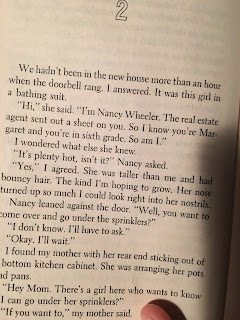 |
Amazon. (2016). October mourning:
A song for Matthew Shepard.
Retrieved from https://www.amazon.
com/October-Mourning-Song-
Matthew-Shepard/dp/0763658073 |
Book Summary: A book of poems exploring the emotions surrounding various people and anthropomorphized items after the hate crime of Matthew Shepherd, a gay college student in Wyoming, who was beaten and left to die, tied to a fencepost on the Wyoming prairie.
APA Reference:
Newman, L. (2012). October mourning: A song for Matthew Shephard. Somerville, MA: Candlewick Press.
Impressions: I’m picky about my poetry. Like our textbook discusses, I hated poetry in high school because it was an exercise in trying to read my teachers’ minds about what the poem’s “true” meaning was. In college, I started writing poetry to cope with my depression, and I learned a lot about crafting images and the lyricism that accompanies certain orders of certain words. I also took an English-majors-required class on poetry, which, that semester, was entirely steeped in the poets of the Harlem Renaissance. Between these experiences, which happened just about on top of each other, I grew in my understanding and appreciation of poetry.
I want poetry that speaks volumes. October Mourning does that to such an extreme that I hope it resonates with every reader, as Leslea Newman states in her author’s note, that it changes the world’s perception of LGBTQA+ persons.
October Mourning is a beautifully layered piece. The first layer is the story of Matthew Shephard’s death. It is a horrific story, which tears through the reader’s mind with bloody, desperate, and violent images. The second layer is how Newman expands the world of who all is affected by the death beyond just Matthew, his parents, his friends, his aggressors, and his college community. The doe, the rope, the fencepost, any and every mother in the world, the box that holds his ashes, the candles lit as vigils across the nation, gay individuals everywhere are all affected by the unnecessary and uncalled-for violence. This illustrates that while Aaron McKinney and Russell Henderson thought they were just beating up a gay guy, they were really beating up anyone who has had a son, a brother, a gay friend, a gay family member. The third layer is the power of words. Newman knew the power her presence would have at University of Wyoming’s Gay Awareness Week just days after Matthew’s death. She knew that the words she provides in these poems will empower others to not forget the horror that this innocent man had inflicted upon him and to fight to make sure it doesn’t happen again.
Professional Review:
Cart, M. (2012, September 15). October mourning [review of October Mourning: A Song for Matthew Shephard]. Booklist, 109(2), 68. Retrieved from http://www.booklistonline.com/
/* Starred Review */ Grades 8-12 On October 6, 1998, 21-year-old Matthew Shepard, a gay student at the University of Wyoming, was lured into a truck, driven into the country, savagely beaten, tied to a fence, and left to die—which he did, five days later. In the 68 poems that make up this novel-in-verse, Newman re-creates the events and circumstances surrounding this unspeakably vile hate crime and offers a moving tribute to a young man she regards as a martyr. Her poems are told from multiple points of view, including that of the fence, the rope that bound the boy, and a doe that stood watch over him. The beautifully realized selections are also written in a variety of forms, ranging from haiku to villanelle, from concrete poetry to rhymed couplets. Each form (discussed in an appendix) matches the tone and mood of its content, creating an almost musical effect that is both intellectually and aesthetically engaging. Written with love, anger, regret, and other profound emotions, this is a truly important book that deserves the widest readership, not only among independent readers but among students in a classroom setting, as well. Most importantly, the book will introduce Matthew Shepard to a generation too young to remember the tragic circumstances of his death.
Library Use: For a series of resources to combat bullying and promote the growth of empathy in readers, books are an important addition. Within the series (which is broken up into resources for different ages: elementary, middle grades, and high school), there are different marginalized groups, such as African-Americans, LGBTQA+, women, etc. October Mourning is to be included in a high school resource for the LGBTQA+ list. Other resources for this group include I’ll Give You the Sun by Jandy Nelson, Aristotle and Dante Discover the Universe by Benjamin Alire Saenz, a search for LGBT on Teen Ink at http://www.teenink.com/search_google.php?q=LGBT&x=0&y=0, The Trevor Project’s website at http://www.thetrevorproject.org/, and more.










